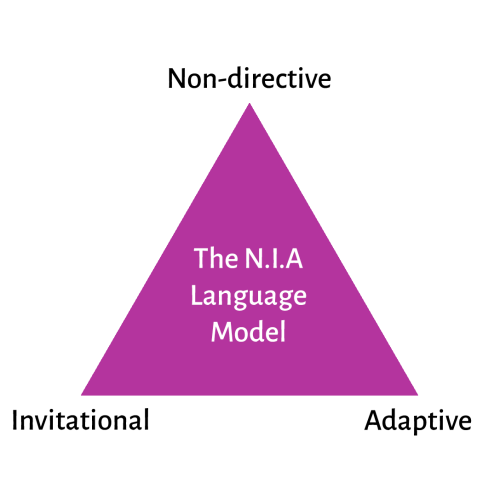What Is the N.I.A Language Model? A Trauma-Sensitive Guide for Mindfulness and Beyond
Teaching Mindfulness using the trauma informed language model N.I.A
In trauma-informed spaces, how we speak matters just as much as what we teach. That’s exactly why the N.I.A Language Model was developed—a simple, powerful framework to help mindfulness teachers communicate in ways that foster emotional safety, choice, and trust.
But this model isn’t just for mindfulness teachers. As trauma-informed care becomes a gold standard across health, education, and wellbeing fields, the N.I.A model is quickly becoming an essential tool for anyone delivering trauma-sensitive support.

Who Created the N.I.A Language Model?
The N.I.A Language Model was co-developed by Nick Cooke and Madeleine Agnew—founders of the Mindfulness Now Teacher Training Programme.
Born from decades of experience in teaching, therapy, and trauma-informed practice, the model was designed as a practical language guide to help mindfulness teachers deliver their sessions in a way that is compassionate, flexible, and empowering—especially for individuals who may have experienced trauma.
What Does N.I.A Stand For?
N.I.A stands for:
1. N – Non-Directive Language
This is language that suggests, rather than instructs. It avoids commands and encourages gentle exploration.
Examples:
“Perhaps you’d like to notice your breath.”
“Maybe you could close your eyes—if that feels okay.”
2. I – Invitational Language
This encourages participants to make choices. It offers options without pressure.
Examples:
“I invite you to bring awareness to your body.”
“The invitation is to gently turn inward, but only if you wish.”
3. A – Adaptive Language
Adaptive language empowers participants to modify the practice in ways that feel safe and personal.
Examples:
“You can focus on your breath—or choose to notice sounds instead.”
“Feel free to adapt this in any way that works for you.”
Why Is the N.I.A Language Model So Useful?
For people with trauma histories, certain mindfulness instructions can feel triggering or unsafe. Phrases like “close your eyes now” or “stay with the discomfort” can lead to disconnection, panic, or a sense of losing control.
The N.I.A model offers a trauma-sensitive alternative that:
Encourages choice and autonomy
Reduces the risk of re-triggering trauma
Builds trust between teacher and participant
Creates a more inclusive space for everyone
In other words, it meets people where they are—and lets them take the lead.
How Easy Is It to Use in Mindfulness Teaching?
One of the best parts of the N.I.A model is its simplicity. You don’t need to change your entire script—just adjust your wording and tone.
Small shifts in language like:
“Notice your breath” → “You might like to notice your breath”
“Sit still” → “You could choose to be still, or move if that feels right”
…can make a huge difference in how safe and supported participants feel.
With just a little practice, the N.I.A language style becomes second nature—and transforms your teaching into a space of true compassion and empowerment.
An Essential Element of Trauma-Informed Mindfulness Teacher Training
The Mindfulness Now Teacher Training Programme has placed the N.I.A model at the heart of its curriculum. It’s not an optional add-on—it’s a core competency.
Why?
Because trauma-informed teaching is no longer optional. It’s essential.
Whether you’re leading a group meditation or offering one-to-one therapeutic support, your language can help participants:
Feel safe in their bodies
Maintain a sense of agency
Engage in mindfulness in a way that supports—not threatens—their nervous system
👉 Learn how to create trauma-sensitive spaces with the Mindfulness Now course here.
Beyond Mindfulness: A Tool for All Trauma-Informed Work
Although the N.I.A model was developed specifically for mindfulness teaching, its principles apply broadly across:
Therapy and counselling
Coaching and mentoring
Yoga and movement practices
Social care and education
Anyone working in trauma-informed care can benefit from using N.I.A-style language—because it places safety, choice, and compassion at the heart of communication.

Final Thoughts: Why N.I.A Matters
In a world where trauma is common but often invisible, the N.I.A Language Model offers a simple yet profound shift: from telling to inviting, from directing to empowering.
Whether you’re a mindfulness teacher, therapist, educator, or healthcare professional, adopting the N.I.A model means you’re doing more than teaching or guiding—you’re helping people feel safe, seen, and in control.
It’s a small change in words… with a big impact
Find out more about trauma informed mindfulness teacher training click here
or for a 4 minute long practice click here
For mindfulness teacher training click here
For CPD trauma informed mindfulness training for mindfulness teachers click here
References
- David Treleaven – Trauma-Sensitive Mindfulness
🔗 https://davidtreleaven.com - Trauma-Sensitive Mindfulness (Book on Amazon)
🔗 https://www.amazon.com/Trauma-Sensitive-Mindfulness-Practices-Transformative-Healing/dp/0393709787 - CASAT OnDemand – The Need for Trauma-Sensitive Mindfulness
🔗 https://casatondemand.org/2023/02/02/the-need-for-trauma-sensitive-mindfulness - Psych Central – Trauma-Informed Mindfulness
🔗 https://psychcentral.com/health/trauma-informed-mindfulness - Psychology Today – Trauma-Informed Mindfulness
🔗 https://www.psychologytoday.com/us/blog/choosing-your-meditation-style/202006/trauma-informed-mindfulness - Grand Rising Behavioral Health – Role of Mindfulness in Trauma Healing
🔗 https://www.grandrisingbehavioralhealth.com/blog/role-of-mindfulness-in-trauma-healing - Wikipedia – Trauma-Informed Mindfulness
🔗 https://en.wikipedia.org/wiki/Trauma-informed_mindfulness
Academic & Clinical Studies
- NIH – Mindfulness as a Mediator Between Trauma and Mental Health
🔗 https://www.ncbi.nlm.nih.gov/pmc/articles/PMC8500672
UK-Based Mindfulness Organisations
Mindfulness Teachers Association – Trusted UK Mindfulness Training Providers
🔗 https://mindfulnessteachers.org.ukBritish Psychological Society – Mindfulness Guidelines
🔗 https://www.bps.org.uk/news-and-policy/mindfulness-guidelines






